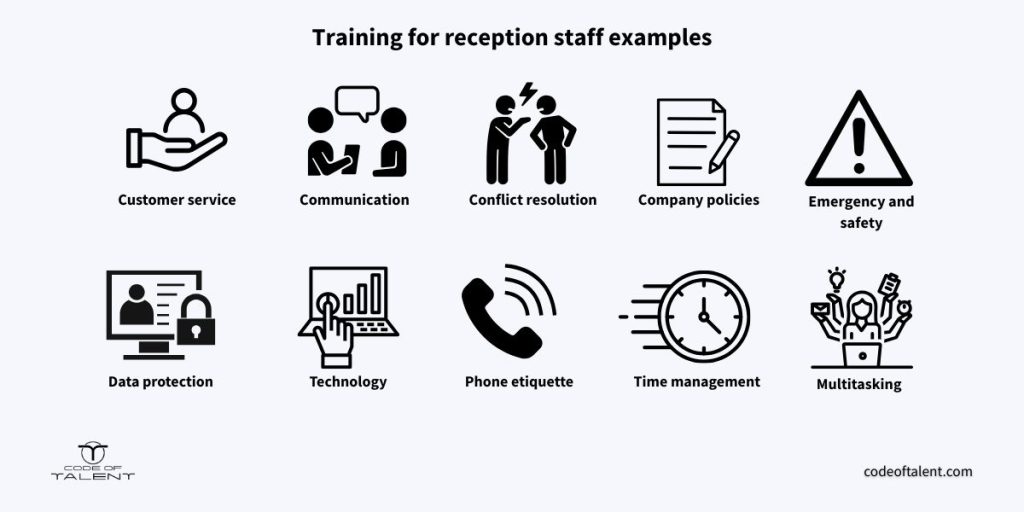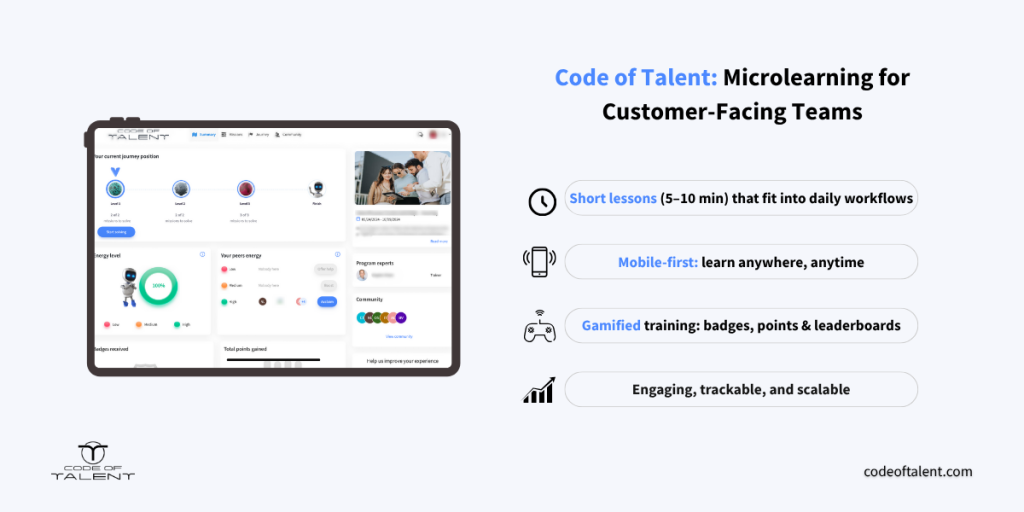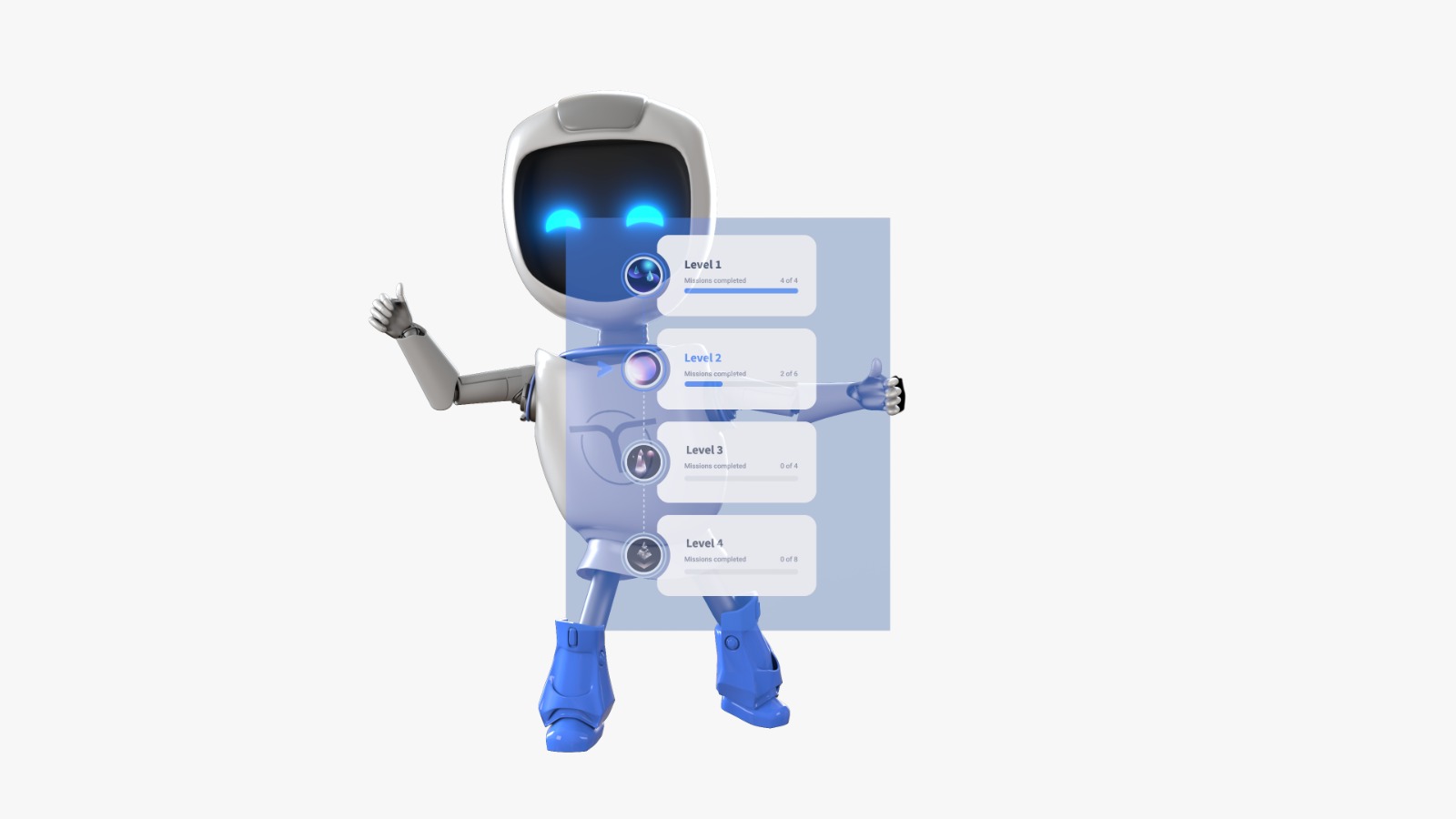Still believe that providing training for reception staff is a waste of money and time? Research says otherwise. A Qualtrics study found that while 95% of guests return after a great experience, 20% never come back after a poor one. And a bad reputation travels fast, as according to Khoros, 67% of customers share negative experiences, and 65% switch to a competitor.

And in a world where online reviews matter to customers more than ever, businesses can’t afford to overlook training for their reception staff. Receptionists, as the first and last point of contact for customers, need the right skills to handle every interaction professionally. And as we all know, first and last impressions tend to stick. That’s why reception staff play a key role in shaping how customers feel about their entire experience.
To help your reception team create great customer experiences every time, it’s important to train them in the right skills. Here are 10 important types of training for reception staff.

1. Customer Service Skills Training
Customer service is a valuable skill set that every receptionist needs to create a positive and welcoming experience. It goes beyond being friendly. It involves knowing how to respond to different people and situations with professionalism and care.
Reception staff often deal with questions, complaints, and high-pressure moments, so knowing how to stay calm and helpful is essential.
This skill includes several key hospitality skills:
- Empathy: recognizing and responding to how the customer feels
- Active listening: giving full attention and showing that the customer is being heard
- Patience: staying composed and respectful, especially when things don’t go as planned
- Problem-solving: quickly finding practical answers that keep the customer satisfied
2. Communication Skills
Strong communication is at the heart of every great customer interaction. Reception staff need to express themselves clearly and understand others just as well—whether face-to-face, on the phone, or in writing. Good communication builds trust, prevents misunderstandings, and helps guests feel respected and well cared for.
Reception training should cover all four types of communication:
- Verbal communication: speaking clearly, using a polite tone, and choosing the right words
- Non-verbal communication: using body language, eye contact, and facial expressions to show attentiveness and confidence
- Written communication: writing professional, friendly messages in emails, chat systems, or booking notes
- Visual communication: presenting information in an easy-to-read format (signs, digital displays, forms)
3. Conflict Resolution and De-escalation
Receptionists are often the first to face frustrated or upset customers. Without the right training, these moments can quickly escalate and affect the entire customer experience. That’s why conflict resolution and de-escalation are essential skills for any front-desk role.
The goal isn’t to “win” an argument, but to calm the situation, protect the business’s image, and find a fair solution.
Key skills to focus on include:
- Staying calm under pressure: managing emotions to avoid reacting defensively
- Listening without interrupting: letting the customer feel heard before offering solutions
- Using a calm, respectful tone: showing empathy without taking sides
- Reframing negative language: turning complaints into opportunities to improve
- Knowing when to escalate: recognizing when to involve a manager or follow formal procedures
4. Company Policies, Procedures, and Product Knowledge
Reception staff represent the business in every interaction, so they need to be well-informed about what the company offers and how it operates. A receptionist who can confidently answer questions, explain policies, or guide a customer through a process builds credibility and trust from the first interaction.
This type of training should cover:
- Company policies: rules on cancellations, refunds, check-in/check-out, privacy, etc.
- Internal procedures: how to handle bookings, complaints, visitor logs, or emergencies
- Product or service knowledge: key features, benefits, common questions, and upsell opportunities
- Brand values and tone: how to reflect the company’s voice and approach in every interaction
5. Emergency Procedures and Self-Safety
Receptionists are often on the front lines during emergencies, which means they must know exactly what to do, not just for customer safety, but for their own. Whether it’s a fire, earthquake, medical emergency, robbery, or physical threat, quick and calm action can save lives and prevent panic.
Emergency training should be a mandatory part of onboarding and cover:
- Evacuation procedures: where to go, who to notify, and how to guide guests safely
- Fire safety basics: using fire extinguishers, alarms, and exits
- Earthquake response: drop, cover, hold, and post-quake safety checks
- Handling criminal threats: what to do in case of a robbery, assault, or suspicious behavior
- Protecting personal safety: staying aware, following protocols, and knowing when to call for help
- CPR training – especially important in industries like hospitality, healthcare, and fitness centers, so receptionists can provide lifesaving assistance when needed
6. Data Protection and GDPR Awareness
Reception staff handle a lot of sensitive information—from personal details in bookings to payment data and private conversations. Protecting this information is a legal requirement under laws like the GDPR (General Data Protection Regulation).
Training on data protection and GDPR awareness helps receptionists understand how to:
- Collect, store, and share customer data securely and responsibly
- Recognize and prevent common data breaches or leaks
- Follow company policies on privacy and confidentiality
- Respond properly to customer requests about their personal data
- Understand the consequences of non-compliance, which can include hefty fines and damage to reputation
7. Technology and Office Equipment Training
Receptionists rely heavily on technology and office equipment to keep daily operations running smoothly.
From managing phone systems and booking software to using printers and security systems, these technical skills are essential for reception staff to work efficiently and avoid delays or frustration, for both themselves and the customers.
Training should include:
- How to use phone systems to answer and transfer calls
- How to manage bookings and appointments with software
- How to operate printers, scanners, and other office machines
- Basic tips for fixing common tech problems quickly
- How to use security systems and follow safety rules
8. Telephone Etiquette Training
Answering the phone is one of the most common tasks for receptionists, and how they handle calls can shape a customer’s entire impression. Good telephone etiquette means being polite, clear, and helpful every time the phone rings.
Training should focus on:
- Greeting callers warmly and professionally
- Speaking clearly and at a friendly pace
- Listening carefully and not interrupting
- Handling difficult or upset callers calmly
- Knowing how to put calls on hold or transfer them smoothly
- Ending calls politely and confirming next steps if needed
9. Time Management
Receptionists often juggle many tasks at once—from greeting visitors and answering calls to handling bookings and managing paperwork. Good time management helps them stay organized, meet deadlines, and keep everything running smoothly without feeling overwhelmed.
Training in time management should cover:
- Prioritizing tasks based on urgency and importance
- Using tools like calendars or to-do lists to stay on track
- Knowing when and how to delegate tasks if possible
- Managing interruptions without losing focus
- Balancing multiple duties without dropping the ball
10. Multitasking and Prioritization
How receptionists present themselves plays a big role in shaping customers’ first impressions. Depending on the industry, some businesses require a uniform, while others allow more flexibility. However, looking neat and professional is always important.
Key points for appearance and dress include:
- Uniforms when required, should be clean, well-fitted, and worn correctly
- If no uniform is required, clothing should be clean, tidy, and appropriate for the workplace
- Avoid overly casual or distracting outfits. Choose simple, professional styles
- Personal grooming matters: neat hair, minimal and tasteful accessories, and good hygiene
- Comfortable but polished shoes are important since receptionists often stand or move around
Implementation Strategies: How to Roll Out Training for Reception Staff Effectively
Training for reception staff is only as good as its delivery. To get the most out of this training, it’s important to choose the right approach, format, and platform.
1. Choose the Right Approach: Microlearning
Microlearning means breaking training into small, easy-to-digest lessons that take just a few minutes each (usually 5-10). This approach fits well into busy workdays, keeps learners interested, and helps information stick.
Instead of long sessions, staff learn in short bursts, which makes training less overwhelming and more practical.
2. Choose the Right Training Format
Different skills need different training styles.
Soft skills are often harder to learn and change because they are influenced by personal biases and past experiences. In contrast, technical skills tend to be easier to understand and follow since they’re based on clear, pre-established guidelines.
That’s why training soft skills usually requires a more human-centered, interactive approach compared to technical skills.
Soft Skills (customer service, communication, time management, conflict resolution):
- Role-playing exercises
- Simulations
- Peer reviews
- Self-reflections
- Short quizzes
- Watching videos
Technical Skills (company policies, data protection, technology, emergencies, dress code):
- Quizzes
- Short videos
- Reading guides on internal policies (5–7 minutes each)
- Refresher materials on technology use
3. Choose the Right Platform: Code of Talent
Code of Talent offers all the tools needed for effective microlearning. Its platform:
- Includes gamification features like leaderboards, medals, points, and badges to make training fun
- Is mobile-friendly, allowing learning anytime and anywhere
- Supports peer review to encourage collaboration and feedback
- Provides on-the-job training capabilities
- Features an AI assistant that helps review responses
- Allows you to easily customize your training by uploading your own materials, which AI transforms into interactive lessons
Using these strategies helps ensure your reception staff get training that fits their needs and schedules, making them more confident and skilled in their roles.

Training for Reception Staff Done Right
Training reception staff is a smart investment that shapes the customer experience from start to finish.
From mastering customer service and communication to understanding emergency procedures and technology, well-trained receptionists help your business stand out for all the right reasons.
If you’re ready to improve your team’s skills and improve customer satisfaction, start with delivering effective training for reception staff today. Try Code of Talent’s free trial to discover how easy and engaging employee training can be!
Cover photo: Freepik





